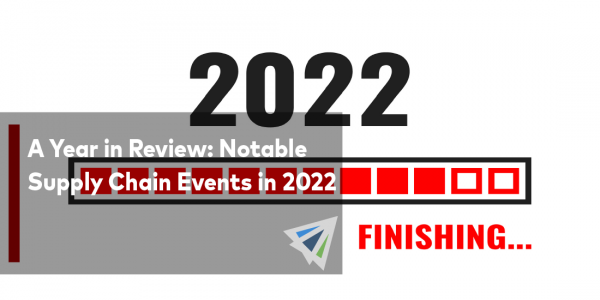Competitive Edge
January 4th, 2023
UPDATE: U.S. and Canada Ports – Number of Cargo Vessels at Anchor
• Vancouver: 35 Vessels at Anchor (-3)
• Savannah: 13 Vessels at Anchor (+9)
• Houston: 25 Vessels at Anchor (+11)
• San Francisco/Oakland: 8 Vessels at Anchor (+4)
• Los Angeles/Long Beach: 8 Vessels at Anchor (-3)
• Mobile: 8 Vessels at Anchor (+4)
• New York/Newark: 4 Vessels at Anchor (+4)
• Charleston: 1 Vessels at Anchor (0)
Note: Count taken on January 3, 2023. This count does not include vessels moored and being unloaded at port docks. Colored numbers in parentheses represents the change from last week over. Data is courtesy of MarineTraffic’s live vessel traffic map.
Have another U.S. or Canadian port you’d like us to track weekly? Let us know!
Takeaways
• U.S. West Coast: 2023 begins with below single-digit ship queues for the USWC.
• U.S. Gulf Coast: Houston has seen a surge in its ship queue as we enter 2023. As a premier freight hub, we suspect arrivals of pre-Chinese New Year sailings have played a role in this boom of traffic. While pre-CNY demand isn’t as pronounced as last year’s, we expect shippers are still planning accordingly around the logistical impacts this annual holiday brings.
• U.S. East Coast: Right before the holidays, Savannah received an early gift of minimal congestion. While not as bad as it was months ago, the EC port saw a nine-vessel addition to its queue this week. Just like many of us on New Year’s Day, Savannah has since experienced a slight hangover in the early days of 2023.
• Canada: New year, same congestion. While Vancouver should expect to see some improvements in the near future, right now it remains an outlier with its vessel queue.
IMPORT: Asia to North America (TPEB)
Recent Developments:
• More blank sailings are expected through Q1 2023, especially right now and this following week ahead of Chinese New Year. In return, carriers hope this move will shed excess capacity and improve overall scheduling.
• West Coast contract negotiations between the International Longshore and Warehouse Union (ILWU) and Pacific Maritime Association (PMA) remain active. The existing labor contract between the two parties expired July 1.
Rates: Spot rates remain hovering around pre-pandemic levels.
Space: Space is open.
Capacity: Overcapacity is the current state of this trade. Blank sailings are now typical as a means from carriers to combat this excess market capacity.
Equipment: Lower volumes have brought relief to equipment deficits. Be on the lookout for improving production of chassis.
TIPS:
• Book at least two weeks prior to the ready date.
• Chinese New Year begins early this year on January 21.
• Expect blank sailings to be commonplace through Q1 2023.
IMPORT: Europe to North America (TAWB)
Rates: Barring any surges in demand, rates are expected to continue to steadily fall in 2023 as this market’s capacity increases.
Space: Space to both U.S. coasts have opened up as American port congestion overall eases.
Capacity: Larger vessels have entered the market boosting the trade lane’s capacity. This applies for both Northern Europe and Mediterranean coasts to the USEC.
Equipment: Availability for both European origins and U.S. destinations has improved for this trade. Inland hubs in Europe are beginning to balance their equipment out as well.
TIPS:
• Book at least four weeks prior to ready date.
• Even as market conditions become favorable, premium services (i.e., no-roll options and improved cargo reliability) should still be considered.
EXPORT: North America to Asia
Rates: Rates are stable if not slightly decreasing. They are not plummeting in this market like its inbound counterpart (Asia to North America).
Capacity: Capacity remains stable. However, blank sailings are still likely as we approach Chinese New Year. That said, they will mostly be limited and not as prevalent as they are expected to be for this lane’s inbound counterpart.
Equipment: Chassis and container deficits still exist at inland points, like Kansas City and Memphis, but buy in large, most dry and coastal ports have balanced out their equipment availability, especially the latter.
TIPS:
• Book at least three weeks prior to the time of departure.
• Stay in close communication with your provider and carrier to be aware of any potential developments, like blank sailings, that can affect your shipments.
InterlogUSA Proudly Presents...

Offering insights into breaking news, market trends, our company’s history, and more.
“FreightFM” features short-form video interviews with InterlogUSA’s industry experts.
Did You Know: Union Pacific Announces New Oregon Intermodal Ramp to Appeal to more Ag Shippers
Agricultural shippers will soon be able to use rail, rather than truck, to bring international containers to the NWSA port in Seattle-Tacoma approximately 200 miles away, according to the Journal of Commerce.
This will also allow shippers to bypass the I-5 corridor which will help reduce truck congestion at the port.
Additionally, this facility is 64-acres, located in Millersburg, Oregon and opened in December.
Freight News
U.S. Southeast Ports Adding Capacity to Handle More Demand
Ports out in the U.S. Southeast have continued to see strong growth in container volumes for the last two years. So, in an effort to handle more demand, infrastructure projects are being added to help expand container handling capacity at the ports of Virginia and Savannah.
The Georgia Ports Authority recently approved a plan that will renovate and realign the ocean terminal docks at the Port of Savannah.
Additionally, the GPA’s Garden City West Project will slowly start opening in phases to provide storage capacity for another 10,000 containers across 167 acres.
The Virginia Port Authority will be focused on the making sure the projects that are set to be completed in 2024, continue to remain on schedule.
Schedule Realiability Sees Improvements for Carrier as U.S. Imports Fall
With help from declining cargo volumes and the decrease in port congestion, on-time performance for ocean carriers in the eastbound trans-Pacific continued to improve in November.
Reliability from Asia to the U.S. West Coast increased nearly 5 percentage points from October to 40.6 percent, also being up from just 9.7 percent in November 2021 – data from Sea-Intelligence Maritime Analysis. In part to declining cargo volumes and port congestion.
Additionally, global schedule reliability improved by 4.7 percentage points month-over-month in November 2022 and reached 56.6 percent. In November 2022, average delay improved once again, dropping to 5.04 days.
And as Sea-Intelligence notes, both schedule reliability and average delay are now better than what they were back in the 2020 level.
Missed Last Month's Webinar? Watch Here Now!
Sign Up for Next Week's Webinar
Our next webinar will be on Wednesday, January 11th!
We will be having RS Logistics Ltd., our agents in China, as our special guests during the webinar.
With Chinese New Year approaching fast, this will be a great webinar to attend to learn more about what is currently happening in China, what things are looking like pre/during/post CNY, and much more.
Interlog  Insights
Insights
This Friday we will be introducing our predictions for the month of January plus other insights relevant to the industry.
Sign up today – you won’t want to miss it!

Sign up for our
industry answers
Our team works to provide valuable, unique, and relevant content to assist you in finding solutions. Sign up now.

